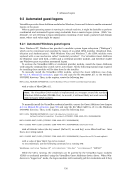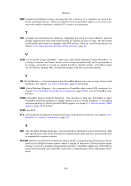9 Advanced topics Finally the iSCSI disk must be attached with the --intnet option to tell the iSCSI initiator to use internal networking: VBoxManage storageattach ... --medium iscsi --server 10.0.9.30 --target iqn.2008-12.com.sun:sampletarget --intnet Compared to a “regular” iSCSI setup, IP address of the target must be specified as a numeric IP address, as there is no DNS resolver for internal networking. The virtual machine with the iSCSI target should be started before the VM using it is powered on. If a virtual machine using an iSCSI disk is started without having the iSCSI target powered up, it can take up to 200 seconds to detect this situation. The VM will fail to power up. 9.8 Launching more than 120 VMs on Solaris hosts Solaris hosts have a fixed number of IPC semaphores IDs per process preventing users from starting more than 120 VMs. While trying to launch more VMs you would be shown a “Cannot create IPC semaphore” error. In order to run more VMs, you will need to bump the semaphore ID limit of the VBoxSVC process. Execute as root the prctl command as shown below. The process ID of VBoxSVC can be obtained using the ps list command. prctl -r -n project.max-sem-ids -v 2048 pid-of-VBoxSVC 9.9 Legacy commands for using serial ports Starting with version 1.4, VirtualBox provided support for virtual serial ports, which, at the time, was rather complicated to set up with a sequence of VBoxManage setextradata statements. Since version 1.5, that way of setting up serial ports is no longer necessary and deprecated. To set up virtual serial ports, use the methods now described in chapter 3.9, Serial ports, page 48. Note: For backwards compatibility, the old setextradata statements, whose descrip- tion is retained below from the old version of the manual, take precedence over the new way of configuring serial ports. As a result, if configuring serial ports the new way doesn’t work, make sure the VM in question does not have old configuration data such as below still active. The old sequence of configuring a serial port used the following 6 commands: VBoxManage setextradata "VM name" "VBoxInternal/Devices/serial/0/Config/IRQ" 4 VBoxManage setextradata "VM name" "VBoxInternal/Devices/serial/0/Config/IOBase" 0x3f8 VBoxManage setextradata "VM name" "VBoxInternal/Devices/serial/0/LUN#0/Driver" Char VBoxManage setextradata "VM name" "VBoxInternal/Devices/serial/0/LUN#0/AttachedDriver/Driver" NamedPipe VBoxManage setextradata "VM name" "VBoxInternal/Devices/serial/0/LUN#0/AttachedDriver/Config/Location" "\\.\pipe\vboxCOM1" VBoxManage setextradata "VM name" "VBoxInternal/Devices/serial/0/LUN#0/AttachedDriver/Config/IsServer" 1 This sets up a serial port in the guest with the default settings for COM1 (IRQ 4, I/O address 0x3f8) and the Location setting assumes that this configuration is used on a Windows host, because the Windows named pipe syntax is used. Keep in mind that on Windows hosts a named pipe must always start with \\.\pipe\. On Linux the same config settings apply, except that the path name for the Location can be chosen more freely. Local domain sockets can be placed 145
Purchased from Demo (abedemo.tizrapublisher.com) for the exclusive use of unknown. © 2025 Demo. Please report unauthorized use to pirate@tizra.com













































































































































































































































































